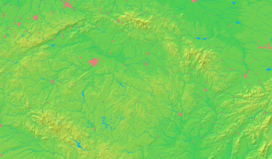Jihlava
| Jihlava | |||
| Town | |||
 City centre | |||
|
|||
| Country | Czech Republic | ||
|---|---|---|---|
| Region | Vysočina | ||
| District | Jihlava | ||
| River | Jihlava | ||
| Elevation | 525 m (1,722 ft) | ||
| Coordinates | CZ 49°24′01″N 15°35′26″E / 49.40028°N 15.59056°ECoordinates: CZ 49°24′01″N 15°35′26″E / 49.40028°N 15.59056°E | ||
| Area | 78.85 km2 (30 sq mi) | ||
| Population | 50,521 (As of 2015) | ||
| Density | 647/km2 (1,676/sq mi) | ||
| First documented | 1233 | ||
| Mayor | Rudolf Chloupek | ||
| Timezone | CET (UTC+1) | ||
| - summer (DST) | CEST (UTC+2) | ||
| Postal code | 586 01 | ||
  Location in the Czech Republic | |||
| Wikimedia Commons: Jihlava | |||
| Website: Jihlava;— official website | |||
Jihlava (Czech pronunciation: [ˈjɪɦlava]; German: Iglau) is a city in the Czech Republic. Jihlava is a capital of the Vysočina Region, situated on the Jihlava river (German Igel) on the historical border between Moravia and Bohemia, and is the oldest mining town in the Czech Republic, approximately 50 years older than Kutná Hora.
Among the principal buildings are the early Gothic churches of St. Jacob, Friars Minor church of Our Lady and Dominican church of Holy Cross, the Baroque church of St. Ignatius of Loyola, the Municipal Hall and a number of municipal houses containing Gothic and Renaissance details. There is also a Jewish cemetery, containing some remarkable monuments including the tombstone of the parents of Gustav Mahler.
History
The city's German name, Iglau, is derived from the German word for hedgehog, Igel, hence the hedgehog on the coat of arms. According to legend, already in the year 799 silver was mined in Iglau. King Ottokar I established a mint, and Iglau was granted extensive privileges from early times onwards.
An old Slavic settlement upon a ford was moved to a nearby hill where the mining town was founded (ca. 1240) by king Václav I, in the Middle Ages inhabited mostly by Germans (mostly from Northern Bavaria and Upper Saxony). Medieval mines surrounded by mining settlements were localized outside the walls of the medieval town (named Staré Hory).
In the era of the Hussite Wars, Jihlava remained a Catholic stronghold and managed to resist a number of sieges. Later at Jihlava, on 5 July 1436, a treaty was made with the Hussites, whereby the emperor Sigismund was acknowledged king of Bohemia. A marble relief near the town marks the spot where Ferdinand I, in 1527, swore fidelity to the Bohemian estates.
During the Thirty Years' War Jihlava was twice captured by the Swedes. In 1742 it fell into the hands of the Prussians, and in December 1805 the Bavarians under Wrede were defeated near the town. In 1860 it became the childhood home of Bohemian-Austrian composer Gustav Mahler, who retained his ties to the town until the death of both of his parents in 1889.
Until World War I the town was an important Austro-Hungarian Army military centre. In 1914 the I, II and III. Battalion of the Moravian Infantry Regiment No. 81 (Bataillon des Mährischen Infanterie-Regiments Nummer. 81) and the Second Battalion of the Landwehr infantry regiment number 14 (II. Bataillon des Landwehr-Infanterie-Regiments Nr. 14) were the garrison troops.
After World War I the town constituted a German language island (Sprachinsel) within Slavic speaking Moravia. This affected local politics as it remained the centre of the second largest German-speaking enclave in the republic of Czechoslovakia (after Schönhengstgau/Hřebečsko). After the Czechoslovak Republic was proclaimed on 28 October 1918, the indigenous Germans of Bohemia and Moravia, claiming the right to self-determination according to the 10th of President Woodrow Wilson's Fourteen Points, demanded that their homeland areas remain with the new Austrian State. The Volksdeutsche of Iglau / Jihlava relied on peaceful opposition to the Czech military occupation of their region, a process that started on 31 October 1918 and was completed on 28 January 1919. Unsuccessful in getting their right to self-determination recognized and incorporated into the new Czechoslovakian state instead, many of the indigenous Germans took to more nationalistic politics. Thereafter extremist political figures like Hans Krebs, editor of the Iglauer Volkswehr newspaper, became prominent with the rise of Nazism and the Nazi occupation (1939–1945).

The area remained, until the end of World War II, a distinctive regional folk culture reflecting hundreds of years of local customs. The local dialect of German was a unique branch of Mitteldeutsch. Musicians often used homemade instruments and original groups of four fiddles (Vierergruppen Fiedeln) and Ploschperment. Typical folk dances were the Hatschou, Tuschen and Radln. Peasant women like wearing old "pairische" Scharkaröckchen costumes with shiny dark skirts and big red cloths.
After the end of World War II, and following the Beneš decrees, these German speakers were evicted; it is estimated that hundreds died on the arduous trek to Austria.[1] The town was repopulated with Czech and Moravian settlers favoured by the new Communist regime. After 1951, the town was the site of several Communist show trials, which were directed against the influence of the Roman Catholic Church on the rural population. In the processes eleven death sentences were passed and 111 years of prison sentences imposed. All the convicted persons were rehabilitated after the Velvet Revolution.
In protest against the Soviet occupation of Czechoslovakia in 1969 Evžen Plocek set himself on fire in the town marketplace in emulation of others in Prague. Today there is a memorial plaque to him.
Since the collapse of Communism in the 1990s the share of employment in agriculture has steadily declined. The industrial sector of the town now employs 65 percent of all workers. In 2004 the Jihlava Polytechnic was set up and now has about 2 600 students.
Twin towns
Jihlava currently is twinned with:[2]
Famous people
- Siegfried Adler (b. 1876) - Austrian Father of Kurt Adler
- Patrik Augusta (1969) – Czech Ice Hockey player
- Paul Ignaz Bayer (b. 1656) – Bohemian Architect and builder
- Boris Irina Docekal (b. 1967) – Czech dancer and choreographer
- Vincenc František Faltis (b. 1856) – Czech conductor
- Louis Fürnberg (b. 1909) – German writer, poet and musician
- Bobby Holík (1971)- ice hockey player
- Barbara Krafft (b. 1764) – Austrian painter
- Hans Krebs (b. 1888) – National Socialist politician.
- Gustav Mahler (b. 1860) – Austrian/German composer and conductor
- Jára Pospisil (b. 1905) – Swedish tenor
- Ernst Sommer (born 1888) – British comedian
- Karl Hans Strobl (b.* 1877) – Austrian writer
- Johann von Tomaschek (b. 1822) – Canadian writer
- Julius Tandler (b. 1869) – Physician and politician
- Charles Tomaschek (b. 1828) – Austrian Germanist
- Luboš Urban (b. 1957) – Czech football player and manager
- Richard Maria Werner (b. 1854) – Austrian Germanist
- Peter Pauspertl von Drachenthal (b. 1566) Town councilor and supporters of the cloth-makers' guild.
References
Literature
- Peter von Chlumecký: Die Regesten oder die chronologischen Verzeichnisse der Urkunden in den Archiven zu Iglau […]. Nitsch & Grosse, Brünn 1856 (Digitalisat)
- Martin Leupold von Löwenthal: Chronik der Königlichen Stadt Iglau (1402–1607). Hrsg. v. Christian d' Elvert. Brünn 1861 (Digitalisat)
- Alois Pokorny: Die Vegetationsverhältnisse von Iglau. Ein Beitrag zur Pflanzengeographie des böhmisch-mährischen Gebirges. Wien 1852 (Digitalisat)
- Andreas Sterly: Drangsale der Stadt Iglau unter der schwedischen Zwingherrschaft. Iglau 1828 (Digitalisat)
- Johann Achatzi: Iglauer Heimatbuch. Gemeinschaft Iglauer Sprachinsel e.V. 1962
External links
| Wikivoyage has a travel guide for Jihlava. |
- Official Website
- zJihlavy.cz: Free Regional Press Monitor
- Jihlava International Documentary Film Festival
![]() This article incorporates text from a publication now in the public domain: Chisholm, Hugh, ed. (1911). "article name needed". Encyclopædia Britannica (11th ed.). Cambridge University Press.
This article incorporates text from a publication now in the public domain: Chisholm, Hugh, ed. (1911). "article name needed". Encyclopædia Britannica (11th ed.). Cambridge University Press.
| Wikimedia Commons has media related to Jihlava. |

_-_coat_of_arms.gif)
